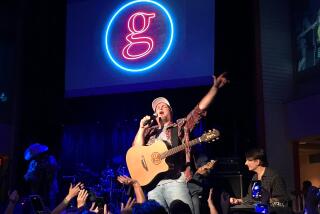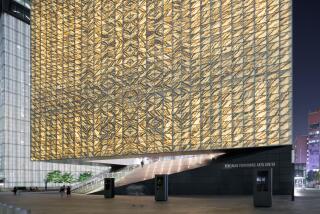Woodstock site rises from its muddy past
BETHEL, N.Y. — No naked mud dancing. And ditch the patchouli. The Woodstock concert site is going upscale this summer.
The $70-million Bethel Woods Center for the Arts opens Saturday with a classical concert just over the hill from where Jimi Hendrix and the Who took the stage 37 years ago. The reincarnated performance venue will welcome back some ‘60s stalwarts -- though the summer schedule also features the New York Philharmonic and Ashlee Simpson. Developers want to attract crowds beyond the site’s tie-dyed core constituency with an eclectic lineup and a pavilion featuring comfy seats and a roof to keep the rain out.
“A lot of people who enjoy the music of the ‘60s, they say, ‘Gee, if we had a place that wasn’t out in the broiling sun and all the rest of that -- and clean bathrooms and good parking,’ ” said Alan Gerry, a wealthy businessman who spearheaded the development through his not-for-profit Gerry Foundation.
Promoters staged the Woodstock concert at Max Yasgur’s farm Aug. 15-17, 1969, after being rejected by the Catskill arts colony that gave the show its name. About 400,000 people came to this rural corner 80 miles northwest of New York City for a rainy weekend that is considered a high-water mark of the ‘60s in more ways than one.
The trampled hayfield left behind endured a more star-crossed history.
The farm was subdivided after Yasgur died in 1973, and subsequent owners of the main site did little with it as hippies dropped by every August for anniversaries. Local officials irritated with the visitors put up barriers and dumped chicken manure on the site. Official anniversary concerts in ’94 and ’99 were held elsewhere. It was looking like a long, bad trip for the Woodstock site.
Enter Mr. Establishment.
Gerry, who made a fortune in the cable business, began buying land around the concert site in the late ‘90s with a mind toward making it into a big-league attraction.
A 76-year-old former Marine raised on country music, Gerry is an unlikely savior for the site. Not only did he take a pass on the original concert, he disciplined a daughter for sneaking off to the show. But he came to see the world-famous hayfield as a way to help his beloved Sullivan County, a lake-dappled area that has never fully recovered from the closures of the old “Borscht Belt” hotels. He developed the site not to make money -- he doesn’t even expect to break even -- but to bring money into the area.
The soaring pavilion that will be christened by the New York Philharmonic on Saturday has 4,800 seats under the roof, and the lush slope of lawn just beyond can accommodate an additional 12,000. Up a winding walkway are two connected buildings with copper roofs and cupolas. One will be an event gallery, the other a Woodstock-themed museum. Both will be open next summer.
Architect Paul E. Westlake said he took inspiration from the temporary wooden buildings of the original concert. All the construction is over the hill from the site of the 1969 stage. The gently sloping hill was left alone in a nod to its historical importance.
Foundation executive director Jonathan Drapkin said the old stage area could be used for concerts, but don’t expect a repeat of ‘69: Local regulations cap crowd size at 30,000.
Woodstock veterans Crosby, Stills, Nash & Young play here Aug. 13 (sign of the times: the top ticket price for CSNY is $126; a one-day ticket to the Woodstock concert was $8).
Other concerts over the summer offer a smorgasbord of pop (Simpson), country (Brad Paisley), rock (Goo Goo Dolls), jam band (Phil Lesh and Trey Anastasio & Mike Gordon) and jazz (a festival featuring Dianne Reeves and Wynton Marsalis).
Drapkin said that Bethel Woods will try a bit of everything as they learn what works. It’s a balancing act: They want to leverage the site’s cultural cachet without limiting themselves to Aquarian nostalgia. Gerry said they need to draw more than just the Woodstock Generation.
For any sort of long-term success, this venue in the middle of cow country also needs to lure people living in the New York City metropolitan area. Manhattan is about two hours away (traffic willing), and the dream is to draw people up from the city to see a show and then have them stay for the weekend.
“We think that someday this will become a destination,” Drapkin said. “But it will take awhile to brand it.”
More to Read
The biggest entertainment stories
Get our big stories about Hollywood, film, television, music, arts, culture and more right in your inbox as soon as they publish.
You may occasionally receive promotional content from the Los Angeles Times.










